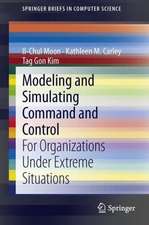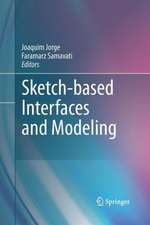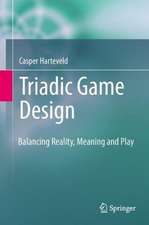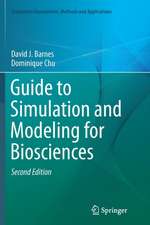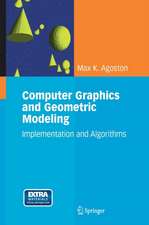Implicit Curves and Surfaces: Mathematics, Data Structures and Algorithms
Autor Abel Gomes, Irina Voiculescu, Joaquim Jorge, Brian Wyvill, Callum Galbraithen Limba Engleză Paperback – 30 oct 2014
Divided into two parts, the first introduces the mathematics of implicit curves and surfaces, as well as the data structures suited to store their sampled or discrete approximations, and the second deals with different computational methods for sampling implicit curves and surfaces, with particular reference to how these are applied to functions in 2D and 3D spaces.
| Toate formatele și edițiile | Preț | Express |
|---|---|---|
| Paperback (1) | 586.38 lei 6-8 săpt. | |
| SPRINGER LONDON – 30 oct 2014 | 586.38 lei 6-8 săpt. | |
| Hardback (1) | 487.56 lei 6-8 săpt. | |
| SPRINGER LONDON – 15 mai 2009 | 487.56 lei 6-8 săpt. |
Preț: 586.38 lei
Preț vechi: 732.98 lei
-20% Nou
Puncte Express: 880
Preț estimativ în valută:
112.21€ • 119.98$ • 93.55£
112.21€ • 119.98$ • 93.55£
Carte tipărită la comandă
Livrare economică 17 aprilie-01 mai
Preluare comenzi: 021 569.72.76
Specificații
ISBN-13: 9781447158776
ISBN-10: 1447158776
Pagini: 368
Ilustrații: XIV, 351 p.
Dimensiuni: 155 x 235 x 22 mm
Greutate: 0.51 kg
Ediția:2009
Editura: SPRINGER LONDON
Colecția Springer
Locul publicării:London, United Kingdom
ISBN-10: 1447158776
Pagini: 368
Ilustrații: XIV, 351 p.
Dimensiuni: 155 x 235 x 22 mm
Greutate: 0.51 kg
Ediția:2009
Editura: SPRINGER LONDON
Colecția Springer
Locul publicării:London, United Kingdom
Public țintă
ResearchCuprins
Mathematics and Data Structures.- Mathematical Fundamentals.- Spatial Data Structures.- Sampling Methods.- Root Isolation Methods.- Interval Arithmetic.- Root-Finding Methods.- Reconstruction and Polygonisation.- Continuation Methods.- Spatial Partitioning Methods.- Implicit Surface Fitting.- Designing Complex Implicit Surface Models.- Skeletal Implicit Modelling Techniques.- Natural Phenomenae-I: Static Modelling.- Natural Phenomenae-II: Animation.
Recenzii
From the reviews:
“The book does contain many algorithm examples and … graphics examples, as well as a scattering of data structures but it would have benefited greatly from a chapter devoted entirely to graphics programming. … A computer graphics specialist who needs to learn how to actually implement the various algorithms would need to look elsewhere. … This book would be ideal as an introduction to the field for a beginning researcher, or for a graphics specialist who wants … introductory information on a particular algorithm.” (Alasdair McAndrew, ACM Computing Reviews, December, 2009)
“The book consist of eleven chapters organized in four parts and can be seen as a self-contained tool for graduate students, researchers, and interested practitioners from industry, regarding the usage of implicit curves and surfaces for computer graphics, geometric modelling, computer games etc. … The book ends with a rich reference section containing more than 400 papers, enforcing the idea that this work represents a valuable source for the reader.” (Mirel Cosulschi, Zentralblatt MATH, Vol. 1190, 2010)
“The book does contain many algorithm examples and … graphics examples, as well as a scattering of data structures but it would have benefited greatly from a chapter devoted entirely to graphics programming. … A computer graphics specialist who needs to learn how to actually implement the various algorithms would need to look elsewhere. … This book would be ideal as an introduction to the field for a beginning researcher, or for a graphics specialist who wants … introductory information on a particular algorithm.” (Alasdair McAndrew, ACM Computing Reviews, December, 2009)
“The book consist of eleven chapters organized in four parts and can be seen as a self-contained tool for graduate students, researchers, and interested practitioners from industry, regarding the usage of implicit curves and surfaces for computer graphics, geometric modelling, computer games etc. … The book ends with a rich reference section containing more than 400 papers, enforcing the idea that this work represents a valuable source for the reader.” (Mirel Cosulschi, Zentralblatt MATH, Vol. 1190, 2010)
Textul de pe ultima copertă
Implicit techniques are a powerful tool that make it easier to describe smooth, intricate, and articulatable shapes via blending and solid geometry, and are becoming the technique of choice in an increasing number of graphics applications.
The mathematics, computational methods and data structures, as well as the algorithms required to render implicit curves and surfaces form the central theme of this book. The increasing importance of implicit objects in geometric modelling stems from the advantages these give over traditional modelling methods; the use of implicit techniques can help simplify complex actions such as point membership classification, which enables the detection of collisions in virtual environments and computer game scenarios.
Graduate students, researchers and developers in computer graphics, geometric modelling, virtual reality and computer games will find this an excellent resource and reference source for modelling and rendering complex geometric objects. The book can also be used as a core textbook for graduate level courses on implicit geometric modelling.
The mathematics, computational methods and data structures, as well as the algorithms required to render implicit curves and surfaces form the central theme of this book. The increasing importance of implicit objects in geometric modelling stems from the advantages these give over traditional modelling methods; the use of implicit techniques can help simplify complex actions such as point membership classification, which enables the detection of collisions in virtual environments and computer game scenarios.
Graduate students, researchers and developers in computer graphics, geometric modelling, virtual reality and computer games will find this an excellent resource and reference source for modelling and rendering complex geometric objects. The book can also be used as a core textbook for graduate level courses on implicit geometric modelling.
Caracteristici
First book to provide a general framework for both implicit curves and surfaces including their mathematical foundations, data structures, computational methods and algorithms Includes both static and dynamic classes of implicit surfaces





